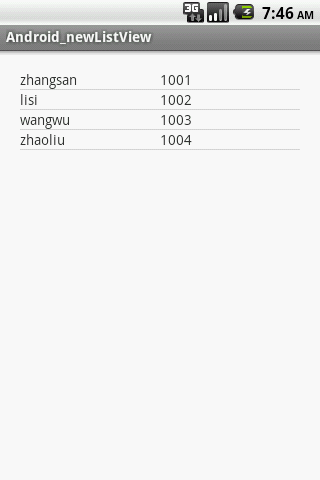几个月前接触Android开发的时候曾经看过ListView的一些基础的使用方法,现在又基本上忘记了,这里总结一下,ListView分成两部分来写吧,首先讲一下最基本的ListView的使用方法,下一节介绍一下通过继承BaseAdapter来实现功能比较全面的ListView。其实我对ListView的使用还不是太透彻,若有大神忘不吝指教~
首先是布局文件,这里需要两个布局文件,一个是放置列表控件的Activity对应的布局文件 main.xml,另一个是ListView中每一行信息显示所对应的布局 list_item.xml 这一步需要注意的问题是ListView 控件的id要使用Android系统内置的 android:id="@android:id/list" [注意形式]
main.xml
<?xml version="1.0" encoding="utf-8"?> <LinearLayout xmlns:android="http://schemas.android.com/apk/res/android" android:layout_width="match_parent" android:layout_height="match_parent" android:orientation="vertical" > <ListView android:id="@android:id/list" android:layout_width="match_parent" android:layout_height="match_parent" android:padding="20dip"/> </LinearLayout>
list_item.xml
<?xml version="1.0" encoding="utf-8"?> <LinearLayout xmlns:android="http://schemas.android.com/apk/res/android" android:layout_width="match_parent" android:layout_height="match_parent" android:orientation="horizontal" > <TextView android:id="@+id/user_name" android:layout_width="match_parent" android:layout_height="match_parent" android:layout_weight="1"/> <TextView android:id="@+id/user_id" android:layout_width="match_parent" android:layout_height="match_parent" android:layout_weight="1"/> </LinearLayout>
然后就设置MainActivity中的代码了:基本思想就是先将数据添加到ArrayList中,然后在设置SimpleAdapter适配器完成设置,入下:
package com.example.android_newlistview; import java.util.ArrayList; import java.util.HashMap; import java.util.Map; import android.os.Bundle; import android.app.Activity; import android.app.ListActivity; import android.view.Menu; import android.widget.SimpleAdapter; public class MainActivity extends ListActivity { String[] from={"name","id"}; //这里是ListView显示内容每一列的列名 int[] to={R.id.user_name,R.id.user_id}; //这里是ListView显示每一列对应的list_item中控件的id String[] userName={"zhangsan","lisi","wangwu","zhaoliu"}; //这里第一列所要显示的人名 String[] userId={"1001","1002","1003","1004"}; //这里是人名对应的ID ArrayList<HashMap<String,String>> list=null; HashMap<String,String> map=null; @Override protected void onCreate(Bundle savedInstanceState) { // TODO Auto-generated method stub super.onCreate(savedInstanceState); setContentView(R.layout.main); //为MainActivity设置主布局 //创建ArrayList对象; list=new ArrayList<HashMap<String,String>>(); //将数据存放进ArrayList对象中,数据安排的结构是,ListView的一行数据对应一个HashMap对象, //HashMap对象,以列名作为键,以该列的值作为Value,将各列信息添加进map中,然后再把每一列对应 //的map对象添加到ArrayList中 for(int i=0; i<4; i++){ map=new HashMap<String,String>(); //为避免产生空指针异常,有几列就创建几个map对象 map.put("id", userId[i]); map.put("name", userName[i]); list.add(map); } //创建一个SimpleAdapter对象 SimpleAdapter adapter=new SimpleAdapter(this,list,R.layout.list_item,from,to); //调用ListActivity的setListAdapter方法,为ListView设置适配器 setListAdapter(adapter); } }
另附图两张:
ListView数据结构示意图:

结果图:

另外对点击某一行作出响应的方法是覆写onListItemClick方法,根据返回的position(从0开始):
@Override
protected void onListItemClick(ListView l, View v, int position, long id) {
// TODO Auto-generated method stub
super.onListItemClick(l, v, position, id);
}
另外ListView进阶教程已出,见链接http://www.cnblogs.com/carlos-vic/p/Carlos_V_Android_6.html